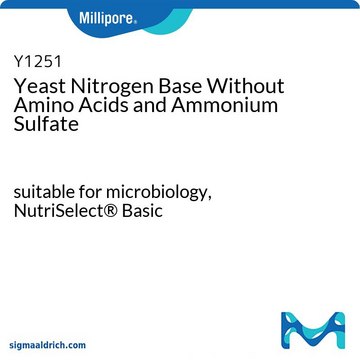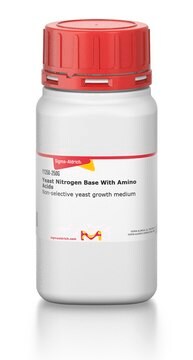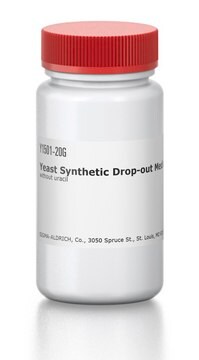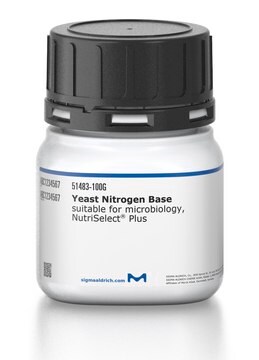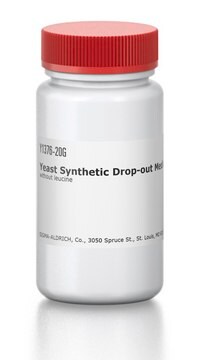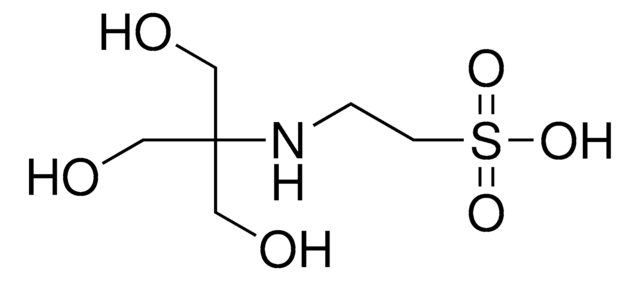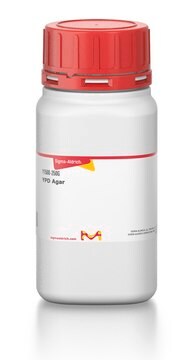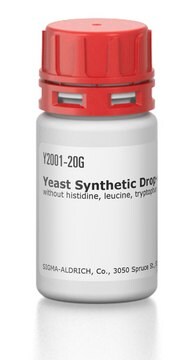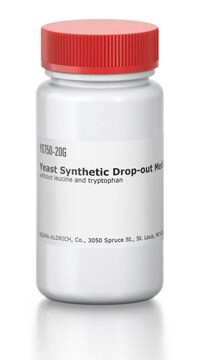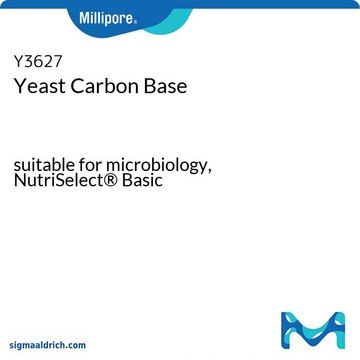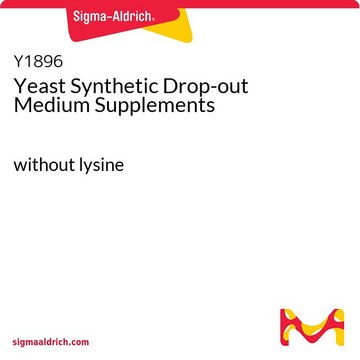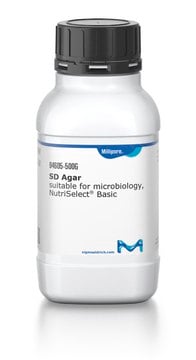Kluczowe dokumenty
Y0626
Yeast Nitrogen Base Without Amino Acids
Yeast classification medium used for selecting yeasts based on amino acid and carbohydrate requirements
Synonim(y):
ynb without amino acids
About This Item
Polecane produkty
klasa czystości
for molecular biology
Poziom jakości
sterylność
non-sterile
Postać
powder
metody
microbe id | utilization test: suitable
microbiological culture: suitable
pH
5.2-5.6(0.67% solution)
Zastosowanie
food and beverages
microbiology
temp. przechowywania
room temp
przydatność
nonselective for Candida spp.
nonselective for Pichia spp.
nonselective for Saccharomyces spp.
nonselective for Zygosaccharomyces spp.
yeasts
Opis ogólny
Zastosowanie
- in synthetic complete supplement mixture (SC)-Leu media used for Y. lipolytica culturing and characterization
- as a component of selective liquid media for uracil auxothrophic growth in yeast
- to evaluate the transformation efficiencies of S. cerevisiae strains, under different nutrient conditions
Komponenty
Nitrogen Sources:
Ammonium sulfate, 5.0 g/L
Vitamins:
Biotin, 2.0
Calcium pantothenate, 400
Folic acid, 2.0
Inositol, 2.0 mg/L
Nicotinic acid, 400
p-Aminobenzoic acid, 200
Pyridoxine HCl, 400
Riboflavin, 200
Thiamine HCL, 400
Trace Elements:
Boric acid, 500
Copper sulfate, 40
Potassium iodide, 100
Ferric chloride, 200
Manganese sulfate, 400
Sodium molybdate, 200
Zinc sulfate, 400
Salts:
Potassium phosphate monobasic, 1.0 g/L
Magnesium sulfate, 0.5 g/L
Sodium chloride, 0.1 g/L
Calcium chloride, 0.1 g/L
Uwaga dotycząca przygotowania
2. Warm if necessary to solubilize and sterilize by filtration.
Store 10× stock solution at 2-8 °C. To use, dilute 1:10 with sterile distilled water under aspetic conditions.
produkt powiązany
Kod klasy składowania
13 - Non Combustible Solids
Klasa zagrożenia wodnego (WGK)
WGK 1
Temperatura zapłonu (°F)
Not applicable
Temperatura zapłonu (°C)
Not applicable
Środki ochrony indywidualnej
Eyeshields, Gloves, type N95 (US)
Certyfikaty analizy (CoA)
Poszukaj Certyfikaty analizy (CoA), wpisując numer partii/serii produktów. Numery serii i partii można znaleźć na etykiecie produktu po słowach „seria” lub „partia”.
Masz już ten produkt?
Dokumenty związane z niedawno zakupionymi produktami zostały zamieszczone w Bibliotece dokumentów.
Klienci oglądali również te produkty
Produkty
Technical Article on yeast media. Yeasts are eukaryotic microorganisms whose genomes have been comprehensively studied and some have been sequenced.
Traditional methods are based morphology, staining methods, enzyme reactions (metabolism) and diverse media.
Tradycyjne metody opierają się na morfologii, metodach barwienia, reakcjach enzymatycznych (metabolizm) i różnych mediach.
Protokoły
Nanocząstki magnetyczno-plazmoniczne: Synteza i zastosowanie nanoperełek Ag/FeCo/Ag do obrazowania i izolacji organelli komórkowych.
Yeasts are considered model systems for eukaryotic studies as they exhibit fast growth and have dispersed cells. Yeast cultures can be grown, maintained, and stored in liquid media or on agar plates using techniques similar to those for bacterial cultures.
Techniki hodowli drożdży: Systemy modelowe do badań eukariotycznych z płynnymi pożywkami lub wzrostem na płytkach agarowych.
Nasz zespół naukowców ma doświadczenie we wszystkich obszarach badań, w tym w naukach przyrodniczych, materiałoznawstwie, syntezie chemicznej, chromatografii, analityce i wielu innych dziedzinach.
Skontaktuj się z zespołem ds. pomocy technicznej